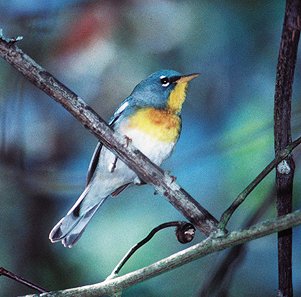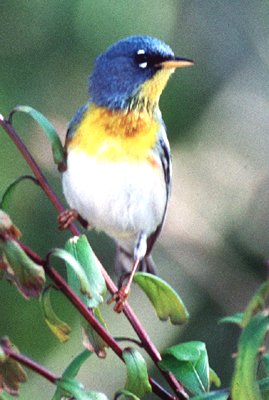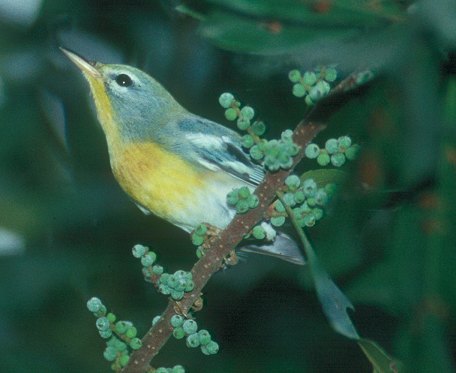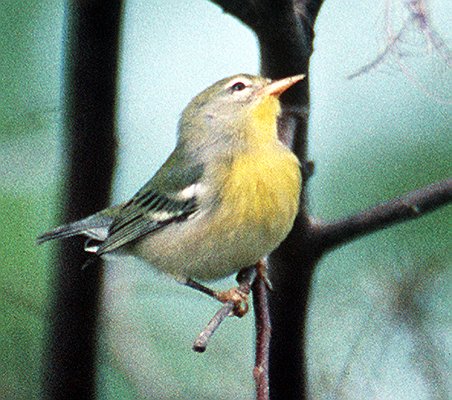|
Northern Parula Parula americana Reinita Pechidorada,
|
 |
|
Male - Photo: G. Beaton
|
|
Northern Parula Parula americana Reinita Pechidorada,
|
 |
|
Male - Photo: G. Beaton
|
|
IDENTIFICATION: A small warbler with bluish upper parts, white wing bars, and a yellow throat and breast. The male has an orange breast band. Length: 11-12 cm.; weight: 5.5-11.2 g. VOICE: Males give a chip note more frequently than females, often scolding forest intruders. Audio 2 (M. Oberle). The song is a series of three to five ascending, buzzy notes, often with a drop at the end, but is usually heard on the winter grounds only in late March and April just prior to migration north. HABITAT: A wide variety of forest types, including primary forests, mangroves, shade coffee plantations, gardens, and coastal scrub forests; early second growth such as scrubby cattle pastures. HABITS: Feeds by gleaning its prey off leaves and branches, but will also hover, or hawk insects in mid-air. In winter, the parula often feeds alone, but may join mixed flocks with other species. It sometimes defends a small, core feeding territory against other parulas, Cape May Warblers and Prairie Warblers. However, at the end of the day, the parula sometimes roosts in a loose flock with other species outside its feeding territory. Males tend to forage higher in trees than females. The winter diet is mostly insects such as beetles, caterpillars, lantern flies, bugs, and some wasps. Spiders make up a large part of the diet as well. The female builds its nest in North America without help from the male. She makes a cup nest in hanging vegetation, especially in epiphytes such as Spanish moss (Tillandsia sp.) or lichen (Usnea or Ramalina sp.). The female incubates the 2-3 eggs for 12-14 days, and the young birds leave the nest 10-11 days after hatching. The male helps feed the young fledglings. As in many species the breed in North American forests, the exact breeding grounds of the populations that winter in Puerto Rico are unknown. However, based on regional song variations and a few returns of banded individuals from other islands, parulas that breed in eastern North America are thought to winter in the Caribbean, while birds that breed in central North America are more likely to winter in Central America. Some parulas arrive in Puerto Rico as early as August, and begin to leave the Caribbean for the spring migration north as early as February, with most birds having departed by May. STATUS AND CONSERVATION: The common migrant warbler species in winter. The breeding range in North America has contracted due to forest fragmentation and the impact of air pollution on tree lichens needed for nest building. The parula has declined in one long-term study area in southwestern Puerto Rico over the last three decades, but some of the wintering warbler species may have simply moved from the maturing forest at that particular study site to more desirable second-growth forest in abandoned pastures. RANGE: Breeds from southeastern Canada and the Great Lakes region to coastal Texas and central Florida. Winters in the Caribbean from southern Florida south to Dominica, and less commonly from the lowlands of southern Mexico, south to Costa Rica. TAXONOMY: PASSERIFORMES; PARULIDAE. A closely related species, the Tropical Parula (Parula pitiayumi), is a permanent resident from Texas to Uruguay. |
|
 |
|
|
Male - Photo: G. Beaton
|
 |
|
|
Male - Photo: G. Beaton
|
 |
|
Female - Photo: G. Beaton
|
 |
|
Female - Photo: G. Beaton
|
 |
|
Female - Photo: M. Oberle
|
 |
|
|
Female - Photo: G. Beaton
|
|
References Arendt, W.J. 1992. Status of North American migrant landbirds in the Caribbean region: a summary. Pp. 143-171 in Ecology and conservation of neotropical migrant landbirds (J.M. Hagan III and D.W. Johnston, eds.) Smithsonian Instit. Press, Washington, D.C. Bent, A.C. 1953. Life histories of North American wood warblers. Smithsonian Instit. U.S. National Museum Bull. 203. (Reprinted by Dover Press, NY, 1963). Cruz, A. 1980. Avian feeding assemblages in Puerto Rico. Carib. J. Sci. 15:21-27. Curson, J., D. Quinn, and D. Beadle. 1994. Warblers of the Americas: an identification guide. Houghton Mifflin, NY. Dunn, J. and K. Garrett. 1997. A field guide to warblers of North America. Houghton Mifflin, NY. Ehrlich, P.R., D.S. Dobkin, and D. Wheye. 1988. The birder’s handbook: a field guide to the natural history of North American birds. Simon and Schuster/ Fireside, NY. Faaborg, J. 1982. Avian population fluctuations during drought conditions in Puerto Rico. Wilson Bull. 94(1):20-30. Faaborg, J. and W.J. Arendt. 1992. Long-term declines of winter resident warblers in a Puerto Rican dry forest: which species are in trouble? Pp. 57-63 in Ecology and conservation of neotropical migrant landbirds (J.M. Hagan III and D.W. Johnston, eds.) Smithsonian Instit. Press, Washington, D.C. Moldenhauer, R. R. and D. J. Regelski. 1996. Northern Parula Warbler (Parula americana). No. 215 in The birds of North America (A. Poole and F. Gill, eds.). Acad. Nat. Sci., Philadelphia, PA, and Am. Ornithol. Union, Washington, D.C. Raffaele, H.A. 1989. A guide to the birds of Puerto Rico and the Virgin Islands. Princeton. Raffaele, H.A. 1989. Una guía a las aves de Puerto Rico y las Islas Vírgenes. Publishing Resources, Inc., Santurce, PR. Raffaele, H.A., J.W. Wiley, O.H. Garrido, A.R. Keith, and J.I. Raffaele. 1998. Guide to the birds of the West Indies. Princeton. Staicer, C.A. 1992. Social behavior of the Northern Parula, Cape May Warbler, and Prairie Warbler wintering in second growth forest in southwestern Puerto Rico. Pp. 308-320 in Ecology and conservation of neotropical migrant landbirds (J.M. Hagan III and D.W. Johnston, eds.) Smithsonian Instit. Press, Washington, D.C. Wunderle, J.M., Jr., and R.B. Waide. 1993. Distribution of overwintering nearctic migrants in the Bahamas and Greater Antilles. Condor 95:904-933. Next related species in taxonomic order Previous related species in taxonomic order |
|